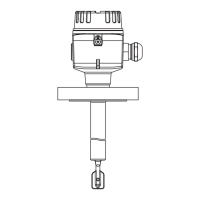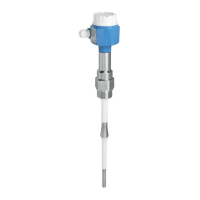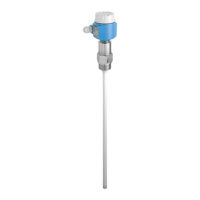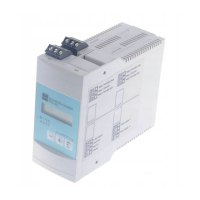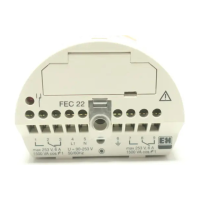Do you have a question about the Endress+Hauser Liquiphant FTL62 and is the answer not in the manual?
Explains the scope and content of the operating instructions for the device's life cycle.
Details safety, electrical, tool, communication, and information symbols used throughout the manual.
Outlines the qualifications and authorization needed for personnel performing tasks on the device.
Defines the proper application of the device and hazards of improper or unintended use.
Advises on PPE, device modifications, repair safety, and hazardous area considerations.
Details device compliance with safety standards and discusses IT security measures.
Details the components and construction of the Liquiphant FTL62, including probe types.
Provides a checklist for verifying the device upon delivery, including order codes and condition.
Lists methods for identifying the device: nameplate, order code, serial number, and online tools.
Covers required storage conditions and safe transport procedures for the device.
Lists critical considerations before mounting: temperature effects on PFA coating and handling.
Explains how fork orientation affects switch points and minimum clearance requirements.
Details how viscosity affects installation and advice on avoiding buildup on the tuning fork.
Provides guidance on supporting the device and lists tools required for mounting.
Details how to align the tuning fork, install in pipes, and manage cable entry.
Explains how to rotate the housing and position the display module for optimal access.
Lists tools for electrical connections and requirements for securing the cover.
Explains potential equalization and provides instructions for connecting the device wiring.
Specifies supply voltage, terminal details, cable requirements, and overvoltage protection.
Provides a step-by-step guide for wiring the device safely and shows terminal assignments.
Describes available cable entries and device plugs, focusing on the M12 plug and pin assignment.
Specifies the IP and NEMA ratings for the device housing and M12 plug.
Provides a checklist for verifying connections, cables, and device integrity after installation.
Lists various methods for operating and configuring the device (keys, display, Bluetooth, tools).
Details operating keys, DIP switches, and current safety modes (MAX/MIN) on the insert.
Explains how to perform a function test using the electronic insert's keys for safety checks.
Compares operating menus and explains user roles (Operator, Maintenance) and access control.
Describes access via the optional device display and operation via Bluetooth wireless technology.
Guides on using the SmartBlue app and accessing menus via HART communication and PC tools.
Describes HistoROM data transfer for electronic insert replacement and data management.
Lists sources for device description files (DTM, DD) and HART load information.
Details measured values assigned to HART protocol variables and their assignment.
Lists device variables and their factory-assigned codes for measured values.
Specifies units for oscillation frequency (Hz) and temperature display (°C, °F, K).
Warns about safety of current output settings and lists as-delivered state parameters.
Advises performing post-mounting/connection checks and switching on the device.
Details connecting via HART protocol and service interface (CDI) for configuration.
Explains how to configure device address via software and set operating language.
Covers configuration using DIP switches, operating keys, and wizards for initial setup.
Details locking/unlocking hardware, display operation, and parameter configuration via password.
Explains how to check the device's lock status via display or operating tool.
Guides on how to read measured values from the device via the Measured values submenu.
Details menus for adjusting device settings to process conditions like level detection and frequency.
Introduces Heartbeat Technology for health checks and proof testing for SIL/WHG devices.
Provides solutions for common issues like device not responding, display problems, and communication errors.
Addresses troubleshooting for SmartBlue connection and operation issues.
Suggests additional tests and explains current output behavior during faults.
Describes how diagnostic messages and status signals (F, C, S) are displayed locally.
Details how diagnostic events are shown in operating tools with NAMUR NE 107 icons.
Explains configuring diagnostic event levels and accessing queued diagnostic messages.
Details viewing diagnostic messages, their remedies, and managing the event logbook.
Guides on resetting the device via software, display, or operating keys on the electronic insert.
States where to find device information and details the importance of firmware version compatibility.
States no special maintenance is required, but details cleaning procedures.
Outlines repair concepts, emphasizes spare parts, and details Ex-certified device repair.
Covers parameter download after replacement and HistoROM functionality.
Guides on returning devices, proper disposal, and lists available accessories like covers.
Specifies measured variables and measuring range based on installation and sensor length.
Describes the SIO output signal, alarm signaling, and load requirements.
Explains damping, switch output delays, and refers to Ex connection data.
Provides HART protocol data and introduces Heartbeat Technology for device checks.
Details ambient temperature, storage temperature, humidity, and operating height limits.
Specifies degree of protection, vibration/shock resistance, and mechanical load capacity.
Lists process temperature range, thermal shock, pressure range, test pressure, and medium properties.
Explains the scope and content of the operating instructions for the device's life cycle.
Details safety, electrical, tool, communication, and information symbols used throughout the manual.
Outlines the qualifications and authorization needed for personnel performing tasks on the device.
Defines the proper application of the device and hazards of improper or unintended use.
Advises on PPE, device modifications, repair safety, and hazardous area considerations.
Details device compliance with safety standards and discusses IT security measures.
Details the components and construction of the Liquiphant FTL62, including probe types.
Provides a checklist for verifying the device upon delivery, including order codes and condition.
Lists methods for identifying the device: nameplate, order code, serial number, and online tools.
Covers required storage conditions and safe transport procedures for the device.
Lists critical considerations before mounting: temperature effects on PFA coating and handling.
Explains how fork orientation affects switch points and minimum clearance requirements.
Details how viscosity affects installation and advice on avoiding buildup on the tuning fork.
Provides guidance on supporting the device and lists tools required for mounting.
Details how to align the tuning fork, install in pipes, and manage cable entry.
Explains how to rotate the housing and position the display module for optimal access.
Lists tools for electrical connections and requirements for securing the cover.
Explains potential equalization and provides instructions for connecting the device wiring.
Specifies supply voltage, terminal details, cable requirements, and overvoltage protection.
Provides a step-by-step guide for wiring the device safely and shows terminal assignments.
Describes available cable entries and device plugs, focusing on the M12 plug and pin assignment.
Specifies the IP and NEMA ratings for the device housing and M12 plug.
Provides a checklist for verifying connections, cables, and device integrity after installation.
Lists various methods for operating and configuring the device (keys, display, Bluetooth, tools).
Details operating keys, DIP switches, and current safety modes (MAX/MIN) on the insert.
Explains how to perform a function test using the electronic insert's keys for safety checks.
Compares operating menus and explains user roles (Operator, Maintenance) and access control.
Describes access via the optional device display and operation via Bluetooth wireless technology.
Guides on using the SmartBlue app and accessing menus via HART communication and PC tools.
Describes HistoROM data transfer for electronic insert replacement and data management.
Lists sources for device description files (DTM, DD) and HART load information.
Details measured values assigned to HART protocol variables and their assignment.
Lists device variables and their factory-assigned codes for measured values.
Specifies units for oscillation frequency (Hz) and temperature display (°C, °F, K).
Warns about safety of current output settings and lists as-delivered state parameters.
Advises performing post-mounting/connection checks and switching on the device.
Details connecting via HART protocol and service interface (CDI) for configuration.
Explains how to configure device address via software and set operating language.
Covers configuration using DIP switches, operating keys, and wizards for initial setup.
Details locking/unlocking hardware, display operation, and parameter configuration via password.
Explains how to check the device's lock status via display or operating tool.
Guides on how to read measured values from the device via the Measured values submenu.
Details menus for adjusting device settings to process conditions like level detection and frequency.
Introduces Heartbeat Technology for health checks and proof testing for SIL/WHG devices.
Provides solutions for common issues like device not responding, display problems, and communication errors.
Addresses troubleshooting for SmartBlue connection and operation issues.
Suggests additional tests and explains current output behavior during faults.
Describes how diagnostic messages and status signals (F, C, S) are displayed locally.
Details how diagnostic events are shown in operating tools with NAMUR NE 107 icons.
Explains configuring diagnostic event levels and accessing queued diagnostic messages.
Details viewing diagnostic messages, their remedies, and managing the event logbook.
Guides on resetting the device via software, display, or operating keys on the electronic insert.
States where to find device information and details the importance of firmware version compatibility.
States no special maintenance is required, but details cleaning procedures.
Outlines repair concepts, emphasizes spare parts, and details Ex-certified device repair.
Covers parameter download after replacement and HistoROM functionality.
Guides on returning devices, proper disposal, and lists available accessories like covers.
Specifies measured variables and measuring range based on installation and sensor length.
Describes the SIO output signal, alarm signaling, and load requirements.
Explains damping, switch output delays, and refers to Ex connection data.
Provides HART protocol data and introduces Heartbeat Technology for device checks.
Details ambient temperature, storage temperature, humidity, and operating height limits.
Specifies degree of protection, vibration/shock resistance, and mechanical load capacity.
Lists process temperature range, thermal shock, pressure range, test pressure, and medium properties.
| Brand | Endress+Hauser |
|---|---|
| Model | Liquiphant FTL62 |
| Category | Switch |
| Language | English |




